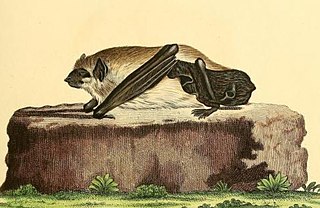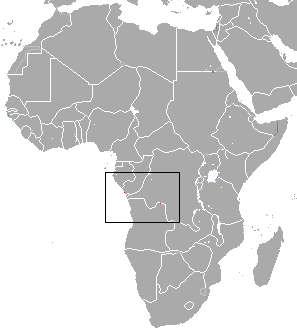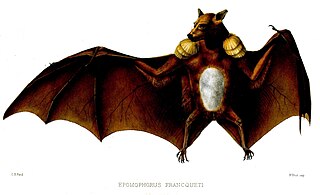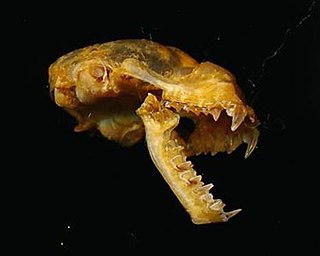
Pohle's fruit bat is a near threatened species of megabat found in the subtropical and tropical forests of Cameroon, the Republic of Congo, Côte d'Ivoire, Ghana, and Liberia.
Curry's bat is a species of vesper bat in the family Vespertilionidae. It is found in Cameroon and Democratic Republic of the Congo. Its natural habitats are subtropical and tropical moist lowland forests and subtropical and tropical swamps.

Schreber's yellow bat or the giant house bat, is a species of vesper bat. It is found in Benin, Democratic Republic of the Congo, Ivory Coast, Ghana, Kenya, Malawi, Mozambique, Nigeria, Senegal, Tanzania, Togo, and Zimbabwe. Its natural habitats are subtropical or tropical moist lowland forests, dry savanna, and moist savanna. It is an uncommon species and its biology is poorly known. It was first described in 1774 by the German naturalist Johann Christian Daniel von Schreber, who named it Vespertilio nigrita. It was later transferred to the genus Scotophilus, making it Scotophilus nigrita.

Casinycteris is a genus of bats described in 1910. It currently consists of three species:
Duke of Abruzzi's free-tailed bat is a species of bat in the family Molossidae. It is found in Cameroon, Central African Republic, Democratic Republic of the Congo, Ivory Coast, Gabon, Ghana, South Sudan, and Uganda. Its natural habitats are subtropical or tropical dry forest, subtropical or tropical moist lowland forest, and moist savanna. It is threatened by habitat loss.

The Gambian epauletted fruit bat is a species of megabat in the family Pteropodidae. It is found in Benin, Burkina Faso, Cameroon, Central African Republic, Chad, Democratic Republic of the Congo, Ivory Coast, Ethiopia, Gambia, Ghana, Guinea, Guinea-Bissau, Liberia, Mali, Niger, Nigeria, Senegal, Sierra Leone, South Sudan, Sudan, and Togo. Its natural habitats are subtropical or tropical dry forests and savanna.

The lesser Angolan epauletted fruit bat is a species of megabat in the family Pteropodidae. It is found in Angola and the Republic of the Congo. Its natural habitats are subtropical or tropical dry and moist lowland forest, and savanna.

The Ethiopian epauletted fruit bat is a species of megabat in the family Pteropodidae. It is found in Burundi, Chad, Republic of the Congo, Democratic Republic of the Congo, Eritrea, Ethiopia, Kenya, Malawi, Mozambique, Nigeria, Rwanda, Sudan, Tanzania, and Uganda. Its natural habitat is savanna.

Franquet's epauletted fruit bat is a species of megabat in the family Pteropodidae, and is one of three different species of epauletted bats. Franquet's epauletted fruit bat has a range of habitats, varying from Subsaharan forest to equatorial tropics.

The Benito roundleaf bat is a species of bat in the family Hipposideridae found in Cameroon, Central African Republic, Republic of the Congo, Democratic Republic of the Congo, Ivory Coast, Equatorial Guinea, Gabon, Ghana, Guinea, Liberia, Nigeria, Sierra Leone, South Sudan, and Togo. Its natural habitat is subtropical or tropical moist lowland forests.

The short-tailed roundleaf bat is a species of bat in the family Hipposideridae. It is found in Cameroon and Equatorial Guinea. Its natural habitats are subtropical or tropical moist lowland forests and caves. It is threatened by habitat loss.

Woermann's bat or Woermann's fruit bat is a species of megabat in the family Pteropodidae. It is monotypic within the genus Megaloglossus. It is found in Angola, Benin, Cameroon, Central African Republic, Republic of the Congo, Democratic Republic of the Congo, Ivory Coast, Equatorial Guinea, Gabon, Ghana, Guinea, Liberia, Nigeria, Sierra Leone, Togo, and Uganda. Its natural habitats are subtropical or tropical moist lowland forests and moist savanna.
The dwarf free-tailed bat is a species of bat in the family Molossidae. It is found in Cameroon, Democratic Republic of the Congo, Ivory Coast, Ethiopia, Ghana, Guinea, Kenya, Nigeria, Sierra Leone, South Sudan, and Uganda. Its natural habitats are subtropical or tropical dry forests and subtropical or tropical moist lowland forests.

The Railer bat is a species of bat in the family Molossidae. It is found in Cameroon, Central African Republic, Republic of the Congo, Democratic Republic of the Congo, Ivory Coast, Equatorial Guinea, Gabon, Ghana, Guinea, Kenya, Liberia, Nigeria, Rwanda, Sierra Leone, and Uganda. Its natural habitats are subtropical or tropical dry forests and subtropical or tropical moist lowland forests.

The Trevor's free-tailed bat is a species of bat in the family Molossidae. It is found in Central and West Africa. Its natural habitats are subtropical or tropical dry forests and moist savanna.

The little collared fruit bat is a species of megabat in the family Pteropodidae found in Angola, Cameroon, the Central African Republic, the Republic of the Congo, the Democratic Republic of the Congo, Ivory Coast, Equatorial Guinea, Gabon, Ghana, Guinea, Liberia, Nigeria, Rwanda, Sierra Leone, South Sudan, Togo, and Uganda. Its natural habitats are subtropical or tropical moist lowland forests and moist savanna.

The Bini free-tailed bat is a species of bat in the family Molossidae found in West and Central Africa. Its natural habitat is subtropical or tropical moist lowland forests.

The halcyon horseshoe bat is a species of bat in the family Rhinolophidae. It is found in Cameroon, Republic of the Congo, Democratic Republic of the Congo, Ivory Coast, Equatorial Guinea, Ghana, Guinea, Kenya, Liberia, Nigeria, Senegal, South Sudan, Togo, Uganda, possibly Gabon, and possibly Sierra Leone. Its natural habitats are subtropical and tropical dry and moist lowland forest, moist savanna, caves, and other subterranean habitats.

The Campo-Ma’an fruit bat is a species of bat found in Cameroon. The first individual encountered was in 2007. It was described as a new species in 2014. Only three individuals have ever been encountered.

Haumania liebrechtsiana is a species of plant in the family Marantaceae. It grows as an understorey herb or climber in tropical forests in Central Africa. The leaves and shoots are eaten by gorillas and chimpanzees, and the leaves and stems have traditional uses.



















